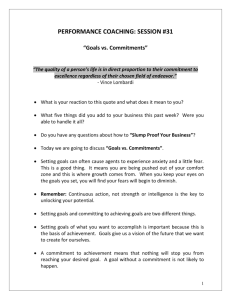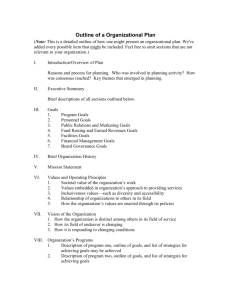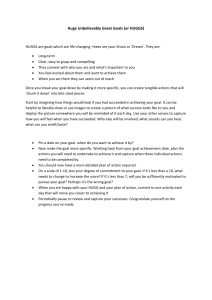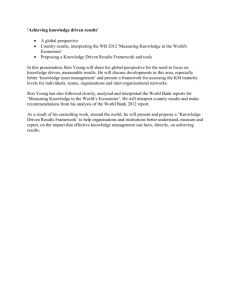Animal Science
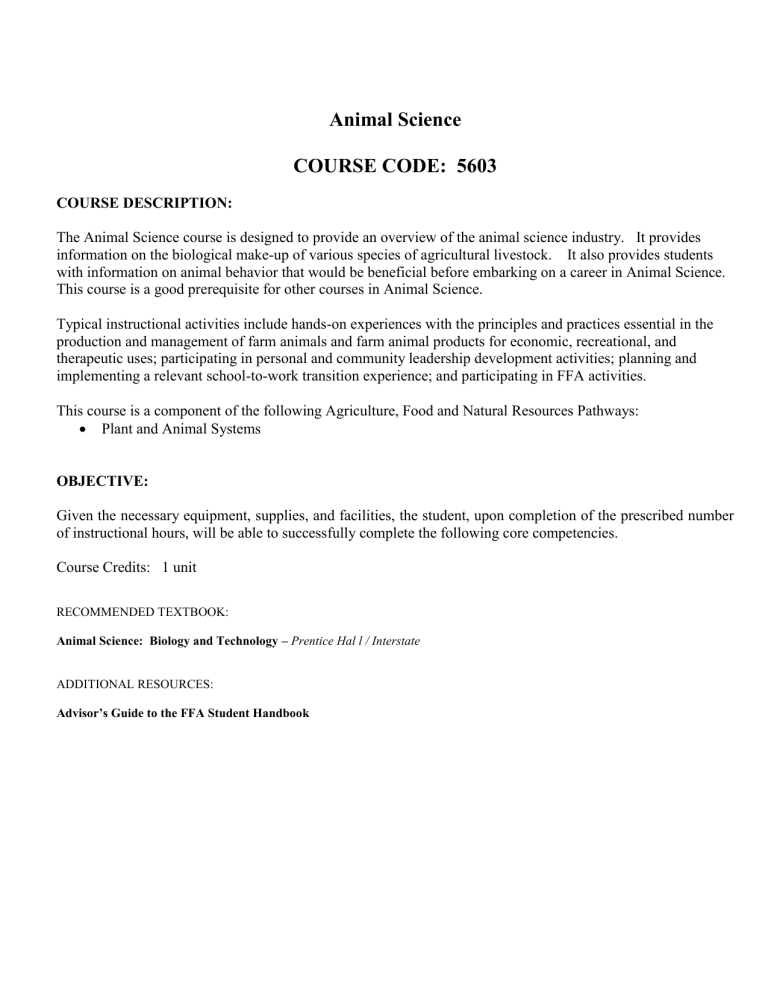
Animal Science
COURSE CODE: 5603
COURSE DESCRIPTION:
The Animal Science course is designed to provide an overview of the animal science industry. It provides information on the biological make-up of various species of agricultural livestock. It also provides students with information on animal behavior that would be beneficial before embarking on a career in Animal Science.
This course is a good prerequisite for other courses in Animal Science.
Typical instructional activities include hands-on experiences with the principles and practices essential in the production and management of farm animals and farm animal products for economic, recreational, and therapeutic uses; participating in personal and community leadership development activities; planning and implementing a relevant school-to-work transition experience; and participating in FFA activities.
This course is a component of the following Agriculture, Food and Natural Resources Pathways:
Plant and Animal Systems
OBJECTIVE:
Given the necessary equipment, supplies, and facilities, the student, upon completion of the prescribed number of instructional hours, will be able to successfully complete the following core competencies.
Course Credits: 1 unit
RECOMMENDED TEXTBOOK:
Animal Science: Biology and Technology – Prentice Hal l / Interstate
ADDITIONAL RESOURCES:
Advisor’s Guide to the FFA Student Handbook
Unit A Developing Leadership Skills in Agriculture
Lesson 1 Planning and Organizing an FFA Meeting
Student Learning Objectives : Instruction in this lesson should result in students achieving the following objectives:
1. Explain how to plan a meeting and develop the order of business.
Describe how to set up the meeting room.
Explain the parliamentary procedure used in an FFA meeting.
2.
3.
Lesson 2 Developing Awareness for Your Community
Student Learning Objectives: Instruction in this lesson should result in students achieving the following objectives:
1. Describe the meaning and importance of community service.
2. List and identify community service organizations.
3. Explain how FFA members can be involved with community improvement and development.
Lesson 3 State FFA Degree
Student Learning Objectives: Instruction in this lesson should result in students achieving the following objectives:
1. List the requirements for the State FFA Degree.
2. Explain how a FFA member can obtain the State FFA Degree.
UNIT B Supervised Experience in Agriculture
Lesson 1 Keeping and Using SAE Records
Student Learning Objectives: Instruction in this lesson should result in students achieving the following objectives:
1
2.
3.
Explain how SAE records are organized.
Identify the procedures to making entries in the SAE records.
Explain how to summarize and analyze the SAE records.
Lesson 2 Making Long Range Plans for Expanding SAE Programs
Student Learning Objectives: Instruction in this lesson should result in students achieving the following objectives:
1.
2.
Identify the factors that should be considered in expanding an SAE program.
Explain how placement and ownership SAE programs may be expanded.
UNIT C Physiology
Lesson 1 Cellular Biology and Animal Taxonomy
Student Learning Objectives: Instruction in this lesson should result in students achieving the following objectives:
1. Draw, label and describe the function of cellular structures.
2.
3.
Differentiate between mitosis and meiosis.
Discuss the relationship of tissues, organs and systems.
4. Trace the domestication of farm animals.
Lesson 2 Growth and Development .
Student Learning Objectives: Instruction in this lesson should result in students achieving the following objectives:
1. Draw and label a growth curve.
2.
3.
Discuss the economic importance of the ideal slaughter point.
Compare and contrast bone growth and muscle growth.
4.
5.
6.
Describe the process of adipose Tissue (fat) deposition.
Differentiate between early and late maturing animals.
Identify two substances that increase the amount of muscle and decrease the amount of fat.
Lesson 3 Muscle and Meat
Student Learning Objectives: Instruction in this lesson should result in students achieving the following objectives:
1. Draw, label and describe the functions of a muscle cell.
2.
3.
4
5
List and distinguish among the types of muscle cells.
Explain post-mortem changes in muscle.
Discuss two factors that can cause differences in meat quality.
Describe two processes that improve meat tenderness.
Lesson 4 Digestion
Student Learning Objectives: Instruction in this lesson should result in students achieving the following objectives:
1.
2.
3.
4.
List six essential nutrients and their functions within the body.
Explain the relationship between gross energy, digestible energy, metabolizable energy and net energy.
Describe the process of digestion.
Compare and contrast digestion in pigs, poultry, cattle, sheep and horses.
Lesson 5 Reproduction
Student Learning Objectives: Instruction in this lesson should result in students achieving the following objectives:
1.
2.
3.
Identify and explain the functions of female and male reproductive tract anatomy.
Analyze physiological changes of the female during fertilization, gestation, parturition and lactation.
Describe practical reproductive differences among swine, cattle, sheep and horses such as signs of heat, length of estrus and gestation period.
Lesson 6 Genetics
Student Learning Objectives: Instruction in this lesson should result in students achieving the following objectives:
1.
2.
3.
4.
Describe how the gender of offspring is determined.
Explain how genotype and phenotype are different.
Differentiate between qualitative and quantitative inheritance.
Identify breeding systems commonly used in commercial animal agriculture.
4. Explain how heritability, selection intensity and generation interval are important to genetic change.
Lesson 3 Ethology: Animal Behavior and Welfare
Student Learning Objectives: Instruction in this lesson should result in students achieving the following objectives:
1.
2.
3.
4.
Give specific examples of maintenance, social and learned behaviors in animals.
Identify behavioral traits that will respond to selection.
Apply the principles of animal behavior to defecating, movement and facilities.
Debate the difference between Animal welfare and animal rights.
UNIT D Livestock Industry
Lesson 1 Swine Industry
Student Learning Objectives: Instruction in this lesson should result in students achieving the following objectives:
1.
2.
Give an overview of the swine industry in the United States
Describe the organization of the swine industry.
3.
4.
5.
Discuss current issues facing the swine industry.
List areas in the swine industry.
Name two organizations that play supporting roles in the swine industry.
Lesson 2 Beef Industry
Student Learning Objectives: Instruction in this lesson should result in students achieving the following objectives:
1.
2.
3.
4.
Give an overview of the beef industry in the United States.
List four production elements of the beef industry.
List careers in the beef industry.
List organizations that support the beef industry.
Lesson 3 Dairy Industry
Student Learning Objectives: Instruction in this lesson should result in students achieving the following objectives:
1.
2.
Describe how most milk is marketed in the United States.
Give an overview of the dairy industry in the United States.
3.
4.
5.
Discuss current issues in the dairy industry.
Describe career opportunities in the dairy industry.
Name two organizations that support the dairy industry.
Lesson 4 Sheep Industry
Student Learning Objectives: Instruction in this lesson should result in students achieving the following objectives:
1. Give an overview of the sheep industry in the United States.
2.
3.
4.
5.
Discuss the role of farm and range flocks in the industry organization.
Explain current issues and trends in the sheep industry.
List three careers in the sheep industry.
Name two organizations that play a supporting roles in the sheep industry.
Lesson 5 Horse Industry
Student Learning Objectives: Instruction in this lesson should result in students achieving the following objectives:
1.
2.
3.
4.
UNIT E Evaluation
Give an overview of the horse industry in the United States.
Explain current issues in the horse industry.
List careers in the horse industry.
Identify organizations that play a supporting role in the horse industry.
Lesson 1 Judging Contests
Student Learning Objectives : Instruction in this lesson should result in students achieving the following objectives:
1. Explain the format of a judging contest.
2. Complete a placing card correctly.
3.
4.
Take notes for use in oral reasons.
Score an incorrectly placed class given an official placing and cuts.
Lesson 2 Performance Data
Student Learning Objectives : Instruction in this lesson should result in students achieving the following objectives:
1. Explain the significance of performance data to livestock breeders.
2. Compare ratios, actual data, multiple-trait indexes, EBVs and EPDs.
3.
4.
Discuss the use of data for various species.
Use performance data in judging classes and on-farm selection.
Lesson 3 Meats Judging
Student Learning Objectives: Instruction in this lesson should result in students achieving the following objectives:
1. Evaluate beef, pork and lamb carcasses and identify primal cuts.
2. Differentiate between yield and quality grades.
3.
4.
5.
Place classes of beef.
Judge pork carcasses.
Discuss elements of judging lamb.
Lesson 4 Livestock Judging
Student Learning Objectives: Instruction in this lesson should result in students achieving the following objectives:
1. Evaluate market animals.
2. a. b.
Describe an ideal market steer, hog and lamb.
Place classes of market steers, hogs and lambs.
Evaluate breeding animals a. Describe ideal male and female breeding stock b. Place classes of male and female breeding stock
Lesson 5 Dairy Cattle Judging
Student Learning Objectives: Instruction in this lesson should result in students achieving the following objectives:
1.
2.
3.
4.
Classify a cow using the Dairy Cow Unified Score Card.
Differentiate between type and linear classification.
Describe the desirable traits of an ideal dairy cow.
Judge and give reasons on a class of dairy cows.
Unit F Developing Communication Skills
Lesson 1 Introduction to Communication
Student Learning Objectives: Instruction in this lesson should result in students achieving the following objectives:
1. Define communication and explain its purpose.
2.
3.
4.
5.
Identify the components of the communication process.
Identify the five different levels of communication.
Explain the barriers of successful communication.
Explain the relationship between communication and leadership.
Lesson 2 Organizing and Presenting a Persuasive Message
Student Learning Objectives: Instruction in this lesson should result in students achieving the following objectives:
1.
2.
Explain the steps in preparing a persuasive message.
Describe delivery techniques in a persuasive message.
Lesson 3 Using Communication Skills in Appropriate Situations
Student Learning Objectives: Instruction in this lesson should result in students achieving the following objectives:
1. Understand the role of communication skills in the workplace.
2.
3.
4.
Understand how to present a problem to a supervisor.
Identify the techniques used in requesting information from a supervisor.
Explain the role of written communication in an agribusiness.
Unit G Gaining Employment
Lesson 1 Developing Goals
Student Learning Objectives : Instruction in this lesson should result in students achieving the following objectives:
1. Explain the process of goal setting.
Describe the terms and types of goals.
Explain some aspects of effective goals.
2.
3.
Lesson 2 Finding a Job
Student Learning Objectives : Instruction in this lesson should result in students achieving the following objectives:
1. Describe information sources for job opportunities.
2. Develop a system to evaluate job openings.
Lesson 3 Applying for a Job
Student Learning Objectives : Instruction in this lesson should result in students achieving the following objectives:
1.
2.
3.
Explain how to research a job opportunity.
Describe two methods of applying for a job.
Identify the common types of information requested on a job application form..
Lesson 4 Writing a Résumé and Letter of Application
Student Learning Objectives : Instruction in this lesson should result in students achieving the following objectives:
1. Explain the purpose of a résumé.
2. List the main items that should be included in a résumé.
3. Describe the purpose of a letter of application and its primary elements.
